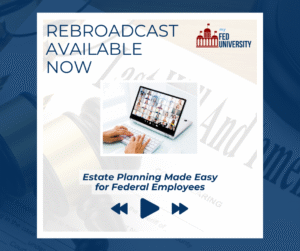FERS/CSRS
FERS
Congress created the Federal Employees Retirement System (FERS) in 1986, and it became effective on January 1, 1987. Since that time, new Federal civilian employees who have retirement coverage are covered by FERS.
FERS is a retirement plan that provides benefits from three different sources: a Basic Benefit Plan, Social Security and the Thrift Savings Plan (TSP). Two of the three parts of FERS (Social Security and the TSP) can go with you to your next job if you leave the Federal Government before retirement. The Basic Benefit and Social Security parts of FERS require you to pay your share each pay period. Your agency withholds the cost of the Basic Benefit and Social Security from your pay as payroll deductions. Your agency pays its part too. Then, after you retire, you receive annuity payments each month for the rest of your life.
The TSP part of FERS is an account that your agency automatically sets up for you. Each pay period your agency deposits into your account amount equal to 1% of the basic pay you earn for the pay period. You can also make your own contributions to your TSP account and your agency will also make a matching contribution. These contributions are tax-deferred. The Thrift Savings Plan is administered by the Federal Retirement Thrift Investment Board.
CSRS
The Civil Service Retirement Act, which became effective on August 1, 1920, established a retirement system for certain Federal employees. It was replaced by the Federal Employees Retirement System (FERS) for Federal employees who first entered covered service on and after January 1, 1987.
The Civil Service Retirement System (CSRS) is a defined benefit, contributory retirement system. Employees share in the expense of the annuities to which they become entitled. CSRS covered employees contribute 7, 7 1/2 or 8 percent of pay to CSRS and, while they generally pay no Social Security retirement, survivor and disability (OASDI) tax, they must pay the Medicare tax (currently 1.45 percent of pay). The employing agency matches the employee’s CSRS contributions.
CSRS employees may increase their earned annuity by contributing up to 10 percent of the basic pay for their creditable service to a voluntary contribution account. Employees may also contribute a portion of pay to the Thrift Savings Plan. There is no Government contribution, but the employee contributions are tax-deferred.
FEGLI
The Federal Government established the Federal Employees’ Group Life Insurance (FEGLI) Program on August 29, 1954. It is the largest group life insurance program in the world, covering over 4 million Federal employees and retirees, as well as many of their family members.
Most employees are eligible for FEGLI coverage. FEGLI provides group term life insurance. As such, it does not build up any cash value or paid-up value. It consists of Basic life insurance coverage and three options. In most cases, if you are a new Federal employee, you are automatically covered by Basic life insurance and your payroll office deducts premiums from your paycheck unless you waive the coverage. In addition to the Basic, there are three forms of Optional insurance you can elect. You must have Basic insurance in order to elect any of the options. Unlike Basic, enrollment in Optional insurance is not automatic — you must take action to elect the options.
If you have option A, B or C coverage with FEGLI it will become more expensive as you age. Like most employer sponsored plans you will see changes in cost and coverage when you separate from federal service. If you are interested in estate planning or have a special needs child you may want to consider a private policy that will give you more control of cost and benefits.
Health Insurance
The FEHB Program can help you and your family meet your health care needs. Federal employees, retirees and their survivors enjoy the widest selection of health plans in the country. You can choose from among Consumer-Driven and High Deductible plans that offer catastrophic risk protection with higher deductibles, health savings/reimbursable accounts and lower premiums, or Fee-for-Service (FFS) plans, and their Preferred Provider Organizations (PPO), or Health Maintenance Organizations (HMO) if you live (or sometimes if you work) within the area serviced by the plan.
You may be eligible to continue your health benefits for you and your spouse during retirement. FEHB will eventually become a Medicare Supplement plan. If you have more questions fill out the contact form and we will help.
Long Term Care
To understand how important it is to start planning for long term care, you need to know how relevant it is to your current situation and how likely you may need help. Below are some startling statistics about long term care in America.
70% of adults aged 65 years and older will require long-term care at some point.
The average length of stay in long-term care is 3.2 years. Just over 20% of residents will require care for 5 years or longer.
Americans spend $475.1 billion annually on long-term care.
Medicaid only covers 54% of America’s long-term care costs.
40% of people receiving long-term care are working-age adults between the ages of 18-64.
74% of consumers ages 55 to 65 polled for a recent survey said they are concerned about needing some kind of long term care.
Aging baby boomers will significantly impact the potential demand for long-term care services over the next two decades. Over the next 20 years, the number of Americans age 65 and older will more than double to 71 million, comprising roughly 20% of the U.S. population.
Women will need care longer (3.7 years on average) than men (2.2 years on average), mainly because women typically live longer.
Without a current option provided, we recommend contacting a financial professional to see if the Federal group policy or a private policy would be the right fit for your individual needs. It is important to explore your options to determine the proper coverage for you and your family.
Military Buy Back
Military Buyback for Federal Retirement
Getting ready for federal retirement? Could a military buyback towards your federal creditable service make sense for you?
Lots of Federal Employees have had prior military service. When we talk about buying back military time in my federal retirement classes – most federal employees want to know, “Does it make sense for me?”
If you have active honorable military service that isn’t already being ‘used’ towards a military retirement – there is a very good chance that you can ‘buy’ that time back and have it count towards your federal retirement.
If you do a military buyback – it will increase the number of years in service that are used for your annuity/pension calculation. The more years you have – the larger your federal pension.
How Much Will It Cost?
How much you will have to pay to buy back your military time depends on these factors…
- When was your service?
- How much were you paid during your military service?
- How much interest has accrued on that time?
- Are you a FERS or a CSRS?
The first step in a military buyback is to find out how much you were paid each year of your military service.
If you have your military pay records – that is the best. However, if you no longer have a copy of your pay records, you can submit a copy of your DD-214 and send a request to your particular branch of the military’s pay center.
Take the amount of military base pay you received during your service, and multiply that amount by a percentage: CSRS use 7%, but FERS use 3%.
VCP
The CSRS Voluntary Contributions Program (VCP) is a special component of the Civil Service Retirement System. While the CSRS originally designed VCP to allow CSRS to put more money in and buy an additional retirement annuity, the big deal about the CSRS VCP program these days is that you can use it to max-fund a Roth IRA.
This is a fantastic benefit for CSRS, especially CSRS who thought they made ‘too much money’ to have a Roth IRA.
Few people have even heard of the VCP, let alone know how to use it to max-fund a Roth. That’s why I call the CSRS Voluntary Contributions Program the best kept secret in CSRS.
If you have questions about VCP, consult a financial professional that has a deep understanding of federal benefits.
Medicare
When you first enroll in Medicare and during certain times of the year, you can choose how you get your Medicare coverage. There are 2 main ways to get your Medicare coverage—Original Medicare (Part A and Part B) or a Medicare Advantage Plan (Part C). Some people need to get additional coverage, like Medicare prescription drug coverage or Medicare Supplement Insurance (Medigap). As a Federal employee, if you qualify to continue your FEHB during retirement, your FEHB will essentially become a Medigap policy.

